The purpose of this exercise is to catch, restrain, gently control, and release the baby every day so that he gets used to giving to pressure from the very beginning. This lesson will also reinforce his earlier contact-imprinting as you enlarge your rubbing, stroking, and manipulating of his body, legs and feet. All of this will give you the softest, most supple and compliant horse imaginable without force or punishment.
Your new foal has been imprinted three or four times in the last 48 hours. It’s time to let baby be baby – with a little control.
 Because he is imprinted, he does not have a great fear of you. As you approach him, he may drift out of your reach, but he will stay with his Mom rather than take off like a shot. Mom needs to be gentle, trusting and controllable during this exercise. Your demeanor and her demeanor dictate the tenor of this “catch” for the baby.
Because he is imprinted, he does not have a great fear of you. As you approach him, he may drift out of your reach, but he will stay with his Mom rather than take off like a shot. Mom needs to be gentle, trusting and controllable during this exercise. Your demeanor and her demeanor dictate the tenor of this “catch” for the baby.
We start by looping a rein loop on his neck. Why not a halter? The answer is obvious if you try to do this with a halter. It is a much more difficult job to try to put a halter on an ever-growing, struggling foal without some type of restraint. It turns into a wrestling match that can teach him some very bad habits.
Instead, we use the neck rein loop for a few days and then proceed to the halter while the loop keeps him under control.
This page contains snapshots of the loop exercise with a 3-day old Friesian colt and a video of a 7-week old Caspian Horse colt.
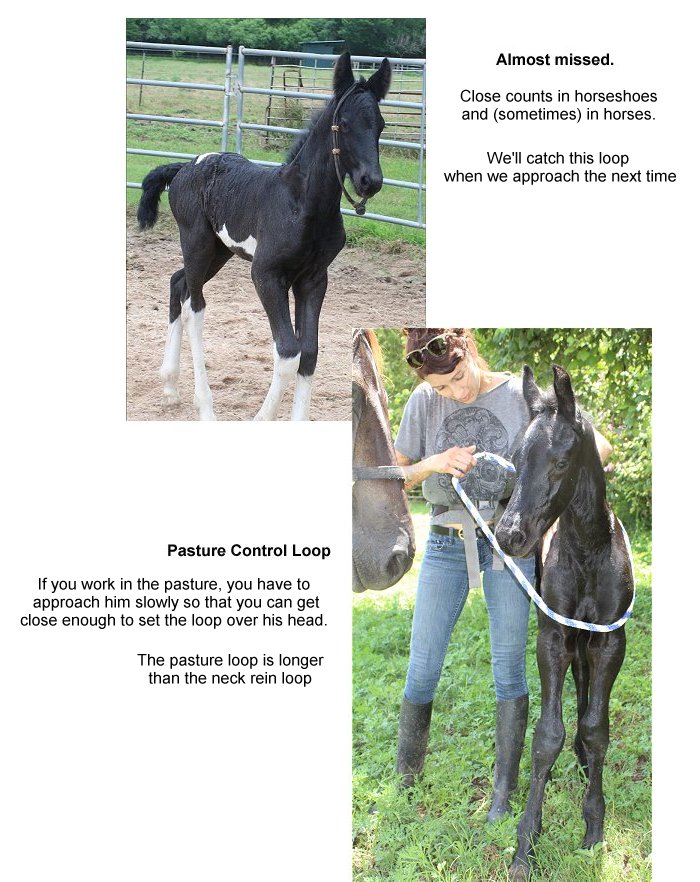
In a pasture (as opposed to a stall), we us a longer loop made of soft marine rope. It’s a little larger, so easier to drop gently over him. We get it over his head using the backward” method of approach. Even 3-day-old foals recognize predator eyes and “I’m going to get you” posture. Read: Fight or Flight.
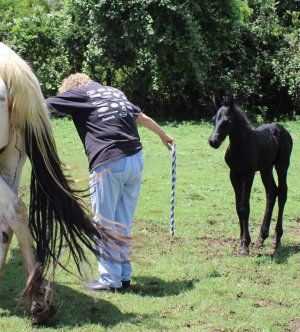 I start by showing him the loop. (left & top picture)
I start by showing him the loop. (left & top picture)
My approach has a very downward look and side or back to the colt, the arm holding the loop outstretched.
If he is uninterested and keeps leaving, I take another approach: truly backing up to him with the loop held in my outstretched hand behind me (where he can see it approaching but I am not looking at him directly). It helps to have another horse-savvy person with you to gently “cut off” his escape route around Mom and distract him a little while you slowly get into position.
 This takes patience as he slowly maneuvers from one side of his Mom to the other to stay out of your reach. When he is in a position that I can gently “place” it over his head (no lassooing or tossing here) I place it there and then back away – letting him wear it a minute or two.
This takes patience as he slowly maneuvers from one side of his Mom to the other to stay out of your reach. When he is in a position that I can gently “place” it over his head (no lassooing or tossing here) I place it there and then back away – letting him wear it a minute or two.
He was Pressured by my approach, and he needs to get release from that tension now that the loop is in place. That is how he will learn that the control loop (and by extension me) is no threat. He can release his pressure by just tolerating it and standing still.
Generally, the foal is completely oblivious to the loop around his neck once you back away. It is soft and non-threatening.
Now “drift” up to him again and gently take hold of the control loop. Be prepared if he startles and jumps forward a little.
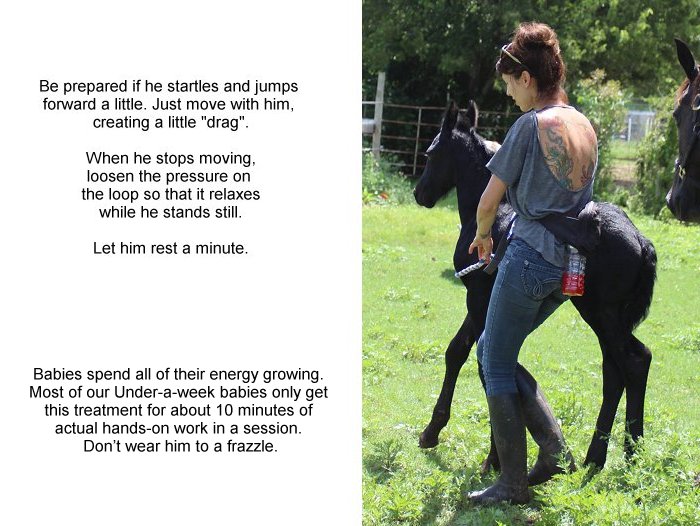
Just restrain while you move with him. When he stops moving, loosen the pressure on the loop so that it relaxes while he stands still. This is a perfect exercise to teach him that pressure ceases when he stands still. Rub his whole body, legs, head, face, ears, tail. Keep a gentle control so that he stays with you while you continue to handle each part of him.
Pick up each foot. He is used to having his legs manipulated, so this should not be too hard. But it is nearly impossible to do without the loop, as he walks out of your hold or objects and learns to fight (very bad). If you have a horse-savvy partner, let them hold the loop while you pick up the feet. Be successful.
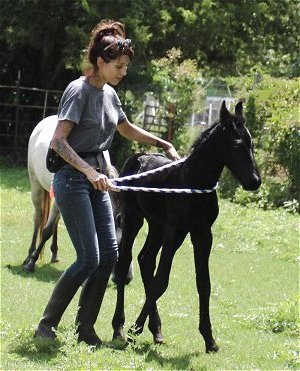 Now “pull” him a little to the side-front to get him to make a little turn-around. Again, release the pressure on the loop the minute he takes a step in the direction of the pull. We will very gradually Shape his response into taking one step, then two steps, then 3 or more steps in the direction you want him to go. He’s small enough that you can get him to turn (this is a 3 day old 3/4 Friesian colt).
Now “pull” him a little to the side-front to get him to make a little turn-around. Again, release the pressure on the loop the minute he takes a step in the direction of the pull. We will very gradually Shape his response into taking one step, then two steps, then 3 or more steps in the direction you want him to go. He’s small enough that you can get him to turn (this is a 3 day old 3/4 Friesian colt).
Be sure that your timing is perfect. Release the pressure when he makes the step and then let him stand still until he relaxes.
Repeat this exercise 1-3 times per day for about 10 minutes per session.
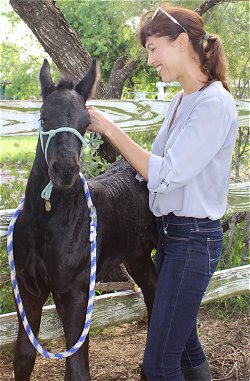 After about a week with just the loop, you will be surprised at how big and strong he is becoming. It is time to re-introduce the halter. He already wore in on his first two days of imprinting. While he is controlled by the loop, keep him close and put the tiny rope halter on his face. This should present little challenge.
After about a week with just the loop, you will be surprised at how big and strong he is becoming. It is time to re-introduce the halter. He already wore in on his first two days of imprinting. While he is controlled by the loop, keep him close and put the tiny rope halter on his face. This should present little challenge.
Attach a lead rope to it. Using the rope on his halter simultaneously with the loop, direct him to move in some direction again. Drop the pressure from both the halter and loop when he complies. Do this for a few more days. (We sometimes run the lead rope from the halter back around his rear so help encourage him to move forward with pressure on both the head AND the rump.) For just a short handling session, feel free to get your hands on him in the pasture using the loop and to direct his whole body with it. For more concentrated training, you will remove the loop and proceed with halter only. (The loop is still a great way to catch him in pasture and to soften his body to pressure to move this way and that.)
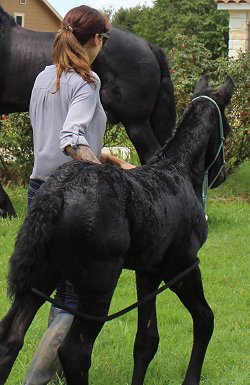 If you will breed the mare again on her foaling heat, this baby must be manageable for travel to the stallion. Read: Breeding on the Foaling Heat. He will be held away from the breeding process (though within sight of the mare), and you must be able to keep him calm and comfortable. He should be mindful of his halter and soft to your requests to change positions.
If you will breed the mare again on her foaling heat, this baby must be manageable for travel to the stallion. Read: Breeding on the Foaling Heat. He will be held away from the breeding process (though within sight of the mare), and you must be able to keep him calm and comfortable. He should be mindful of his halter and soft to your requests to change positions.
After the first few of days with the halter, we will start to de-sensitize him. Then move on to disengaging his rear and front. All of these exercises are so much easier now than they are with a yearling or older horse who has not been introduced early.
(More about his 3rd week in the next Post)
Babies spend all of their energy growing. Most of our Under-a-week babies only get this treatment for about 10 minutes of actual hands-on work in a session. Don’t wear him to a frazzle.
Horse training can be dangerous. Not all methods work on all horses. Instruction presented here is not meant to be prescriptive in nature, and Horse-Pros.com takes no responsibility for the welfare of any animal or person using our methods.
Please note that any advice given on horse-pros.com is neither veterinary nor prescriptive in nature but offered only as an introduction to this topic.
We need your help. We certainly don’t know everything. Please share your expertise and experiences. Comment on what is already written or Suggest a Category and Educate us about it. Grow Horse-Pros.com©
